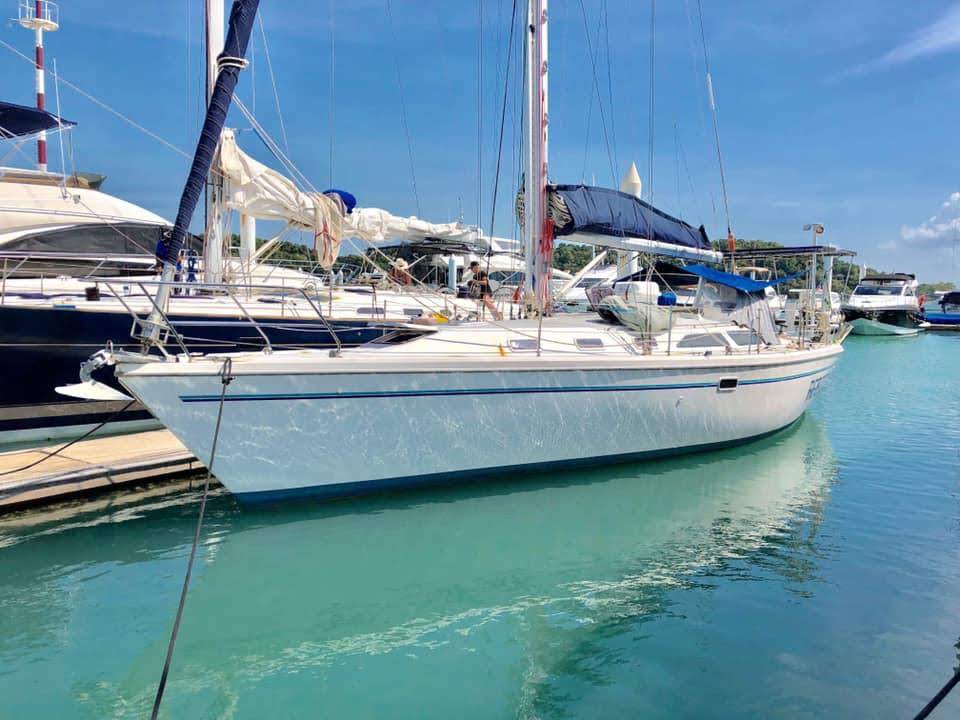...................
OK, a number of things:
- Size of Boat: In general bigger is more comfortable but more important is faster. An increase in average speed of one knot means 24 NM per day. When you are doing 2700 NM transits (about the non-stop distance across the Atlantic) you gain a day for every four days you sail (most people plan on 100 NM per day on a transit unless they have a very slow boat.) The downside is weight. The heavier the boat the harder it is to deal with that last 5 feet (dock, mooring, etc.) In the "old days" "cruising boats" were built very heavy. The general idea was they were safer. But they were slow and made it more difficult not only docking but trying to avoid weather. So when you look at boats make sure you consider the weight too.
- Physical strength: Realize that sailing a boat require physical strength. Ketch rigs exist in part so that each sail is smaller and easier to handle. Trying to furl a headsail when a thunderstorm comes up can easily exceed one's physical ability. (Yes, reef early, reef often!) You can 'trick out" a boat to make it easier (oversized winches, etc.) but in the long run you need to be able to handle the day to day sailing - that means in winds up to about 30 knots. Putting the outboard on the dinghy, raising and lowering the dinghy, and getting that heavy anchor secured properly all require physical strength.
- Learning to Sail: I approve of your desire to take sailing courses but in my humble opinion you are spending a lot of money for very little experience. You will get far more experience for far less money crewing on other people's boats. There are crew finding web sites - I post for crew on Find Crew®, Worldwide matching of Marine Crew and Boats.. Most of us who have been sailing a while (for me about 57 years and 20,000 NM) have learned a few things along the way. Find Captains who like to teach.
- Racing: A great way to improve your skills is to crew on a race boat. Most local yacht clubs have "around the buoy" racing a couple of times a week. For an investment of about 5 hours per race you will learn a lot about sail trim in a short time. Yes, you don't know much but there are always skippers who love to teach (also those who are horror shows and no one will crew with them!)
- Buying a boat: Unless you have a specific need to own a boat postpone purchase as long as possible. Boats age. Not only do they lose value over time but the "big deals" are corrosion and condensation. A boat sitting on a dock will suddenly have things that don't work as a consequence. Yes, you will learn how to maintain things. Let Captains on boats that you crew on give you the education rather then using your time and wallet. Plus you really don't have any idea what kind of trade offs you want to make. As an aside Enterprise Rent a Car in the US has a great winter weekend special - $9.95 per day for the weekend. I have rented a whole bunch of different cars from them over the past couple of years. What an education! There are brands and models I would not accept if someone gave me a car. The same is true of boats. Sail on as many different brands and models as you can.
- Transit times: Long distance cruising has specific routes and times of year. If you want to get some long distance experience sign on for a transit: Europe to the Caribbean in November, US North to South in November, Eastbound to Europe from the US and Caribbean in June. The commitment would be about a month in each case and the experience would be invaluable.
- Budget: It is important that you start to keep records and focus on developing a budget. When you are ready to purchase a boat figure you can only spend 50% or 60% of your "purchase" budget on the boat. The rest you will need for immediate repairs (the ones the surveyor didn't tell you about) and equipment upgrades.
- Single handing: Most of my recent sailing has been semi-single handed - I do have the most adorable cat named "XO" (after the second in command on a Navy ship, the Executive Officer. See: XO The Wonder Cat It can get very lonely. Most insurance companies will not cover the boat after a certain amount of time underway (24 hours is pretty standard) until you stop for a rest period (12 hours is pretty standard.) It is also very tiring during long transits as you get very little sleep. Falling overboard is not an issue - we use harnesses to tie ourselves to the boat. That said hell hath no punishment like having a crew member you can't stand and can't get rid of on board. My guess is few of us single hand for the challenge, we just haven't met people we would like to crew with long term.
- Single handing in port: A common complaint of most single men is that they are treated like pariahs in port by the married couples. I don't know if being a female would be different but I think not. (poof, he disappears*)
Fair winds and following seas :)
*cogito ergo sum (I think, therefore I am - René Descartes)


